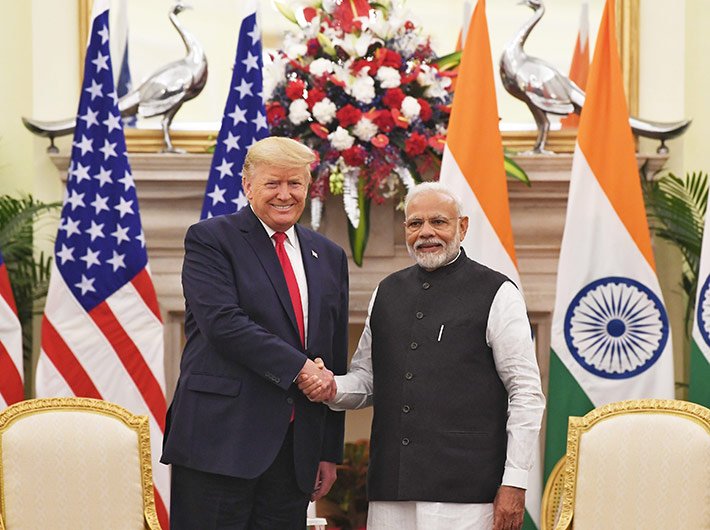The two sides are now committed to do away with frictions that separated them for so many years
In the more than 40 hours of stay in India during his two-day visit, US president Donald Trump exhibited his talents as a politician and also a showman with acumen to provide the Indian audience and Americans back home enough opportunity to stay glued to his activities on the Indian soil. Whether it be his address to a huge gathering amid rapturous greetings from locals at the Motera stadium in Ahmedabad, which was preceded by a grand roadshow, or a brief stopover at Sabarmati Ashram where he tried his hands at the charkha, president Trump was a picture of attraction. Then at Agra, he and first lady Melania Trump stood before the iconic Taj Mahal, got photographed together and left for New Delhi for the official engagement, but not before writing in the visitors’ book: “Taj Mahal inspires awe, a timeless testament to the rich and diverse beauty of Indian culture! Thank you, India.”
In the national capital, Trump and Modi bonhomie was at its zenith with the two countries discussing ways to enhance their cooperation on home security front to jointly fight international crimes like human trafficking, terrorism, extremism, drug-trafficking and cybercrime. The two sides also announced their intent to establish a Counter-Narcotics Working Group to fight drug-trafficking. In their joint statement, the two sides welcomed the decision by the Ministry of Home Affairs and the US Department of Homeland Security to reinvigorate the Homeland Security Dialogue.
On the defence front, the two countries pledged to “deepen defense and security cooperation, especially through greater maritime and space domain awareness and information sharing; joint cooperation; exchange of military liaison personnel; advanced training and expanded exercises between all services and special forces; closer collaboration on co-development and co-production of advanced defense components, equipment, and platforms; and partnership between their defense industries.” For the first time in the history of New Delhi-Washington defence partnership, the US administration has placed India at the Strategic Trade Authorisation-1(STA-1) level, paving the way for high-technology product sales to the country in space and defence sectors. After Japan and South Korea, India is the third Asian country to get STA-1 status.
However, the major takeaway of India-US defence partnership during Trump’s visit was the $3billion defence deal, under which India will acquire 24 MH-60R Seahawk maritime helicopters from the US-based Lockheed Martine group. While the purchase of such military platforms will enhance India’s capability in the Indian Ocean region, the two countries also expressed their optimism for the early conclusion of defence cooperation enabling agreements, including Basic Exchange and Cooperation Agreement.
On the space front, the two countries welcomed moves taken by the Indian Space Research Organisation (ISRO) and National Aeronautics and Space Administration (NASA) for development and launch in 2022 a joint mission with the world’s first dual-frequency Synthetic Aperture Radar satellite.
Although the two countries failed to seal the trade deal, they agreed to promptly conclude the ongoing negotiations for a comprehensive bilateral trade agreement. “They agreed to promptly conclude the ongoing negotiations, which they hope can become phase one of a comprehensive bilateral trade agreement that reflects the true ambition and full potential of the bilateral commercial relations, advancing prosperity, investment, and job creation in both countries,” the India-US joint statement maintained.
In the recent past, India has begun looking for the US for its energy security also. India has been sourcing LNG and crude oil from the US, with Indian companies investing $4 billion in US shale gas assets. Over the next 25 years or so, India’s energy demand is expected to grow at 4.2 percent a year. In view of this, it has contracted 9 million metric tonnes per annum (mmtpa) of LNG from the US, making it the sixth largest buyer of the US LNG. Then under the rubric of India-US energy security partnership, the two countries are finalizing their negotiations for the construction of six nuclear reactors in India.
Overall, the US presidential visit remained substantial in further strengthening the two countries ties. To the chagrin of China, however, the two countries made that proclamation on the Indo-Pacific region, which Beijing considers as anti-China. “A close partnership between the United States and India is central to a free, open, inclusive, peaceful, and prosperous Indo-Pacific region. This cooperation is underpinned by recognition of ASEAN centrality; adherence to international law and good governance; support for safety and freedom of navigation, over flight and other lawful uses of the seas; unimpeded lawful commerce; and advocacy for peaceful resolution of maritime disputes in accordance with international law,” read the joint statement. While it reflects the growing bond between the two countries, it also shows that the two sides are now committed to do away with all those frictions that separated them for so many years, particularly during the Cold War era.

